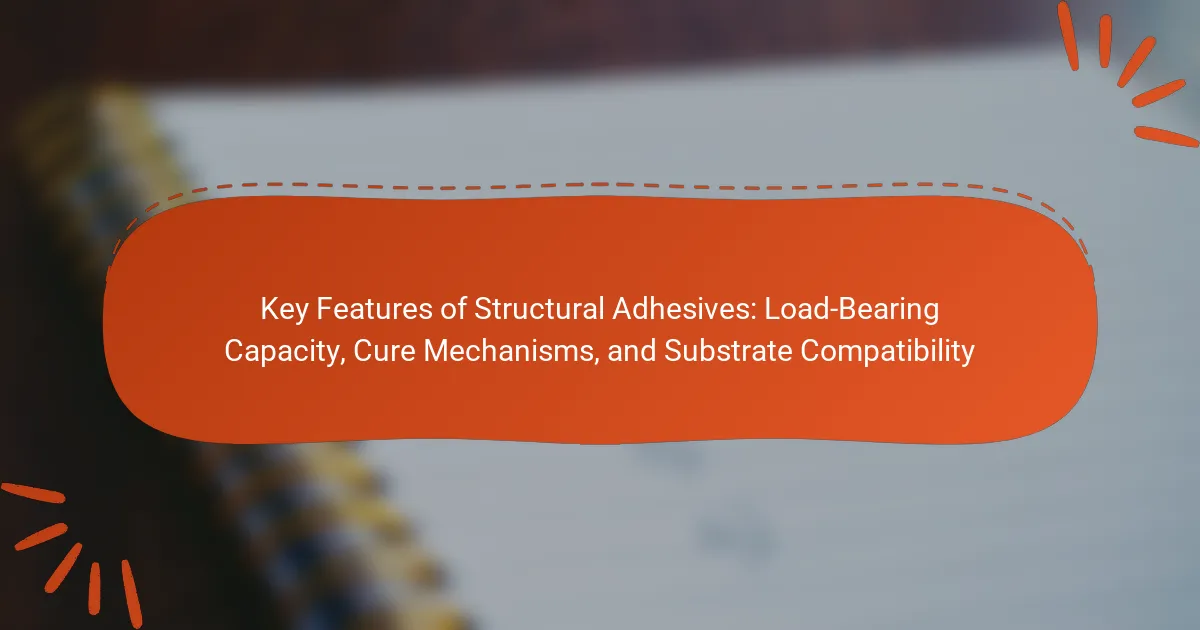Structural adhesives are high-strength materials designed to bond various substrates, providing essential load-bearing capacity. Their performance is influenced by curing mechanisms, which include heat, moisture, or chemical reactions, and compatibility with specific materials such as metals, plastics, or composites. The effectiveness of these adhesives relies on the interrelated factors of load-bearing capacity, cure mechanisms, and substrate compatibility. Best practices for their use involve proper surface preparation, careful adhesive selection, and adherence to application guidelines to ensure optimal adhesion and durability. This article explores these key features and best practices for utilizing structural adhesives effectively.

What are the Key Features of Structural Adhesives?
Structural adhesives are materials designed to bond different substrates with high strength. They provide load-bearing capacity, enabling them to withstand significant forces. Structural adhesives cure through various mechanisms, such as heat, moisture, or chemical reactions. This curing process determines their performance and application suitability. Compatibility with substrates is crucial for effective bonding. Different adhesives work best with specific materials, such as metals, plastics, or composites. This ensures optimal adhesion and durability in various environments. Overall, the key features of structural adhesives include high strength, diverse curing methods, and substrate-specific compatibility.
How do Load-Bearing Capacities influence Structural Adhesives?
Load-bearing capacities significantly influence the performance and selection of structural adhesives. These capacities determine how much weight or stress an adhesive can withstand before failure. Higher load-bearing capacities enable adhesives to bond heavier materials or endure greater forces in applications.
Structural adhesives with high load-bearing capacities are essential in industries such as construction and automotive. For example, epoxy adhesives often exhibit superior load-bearing properties compared to other types. This characteristic allows them to be used in critical applications where safety and durability are paramount.
Additionally, the load-bearing capacity influences the adhesive’s curing process and the choice of substrates. Adhesives must cure effectively to achieve their maximum load-bearing potential. Choosing the right adhesive based on load-bearing requirements ensures structural integrity and longevity in bonded assemblies.
What factors determine the Load-Bearing Capacity of Structural Adhesives?
The load-bearing capacity of structural adhesives is determined by several factors. These include adhesive formulation, bond thickness, and substrate material properties. The chemical composition of the adhesive affects its strength and durability. Bond thickness influences stress distribution; thinner bonds may lead to higher stress concentrations. Substrate material properties, such as surface roughness and tensile strength, also play a critical role. Environmental factors like temperature and humidity can impact adhesive performance. Testing methods, such as shear and tensile tests, provide empirical data on load-bearing capacity. Research indicates that optimized adhesive systems can achieve significant load-bearing capabilities when properly applied.
How does Load-Bearing Capacity affect the choice of Structural Adhesive?
Load-bearing capacity significantly influences the choice of structural adhesive. Higher load-bearing capacity adhesives are essential for applications involving heavy loads. These adhesives must withstand tensile and shear stresses without failure. For instance, adhesives used in construction must support the weight of structural elements. In contrast, lighter applications may utilize adhesives with lower load-bearing capacities. The specific load requirements dictate the adhesive formulation and curing process. Adhesives with enhanced load-bearing properties often incorporate advanced polymers or fillers. Testing standards, such as ASTM D1002, help determine adhesive performance under load. Therefore, understanding load-bearing capacity is crucial for selecting the appropriate structural adhesive for any given application.
What are the different Cure Mechanisms for Structural Adhesives?
Structural adhesives utilize several cure mechanisms. These mechanisms include solvent evaporation, heat curing, moisture curing, and light curing. Solvent evaporation occurs when solvents in the adhesive dissipate, allowing the adhesive to bond. Heat curing involves applying heat to accelerate the curing process and enhance bond strength. Moisture curing relies on the presence of moisture to initiate a chemical reaction that solidifies the adhesive. Light curing uses ultraviolet or visible light to trigger polymerization, quickly forming a solid bond. Each mechanism is essential for achieving optimal performance in various applications.
How do different Cure Mechanisms impact the performance of Structural Adhesives?
Different cure mechanisms significantly impact the performance of structural adhesives. Cure mechanisms include thermal, moisture, and UV curing. Each mechanism affects the adhesive’s bond strength, setting time, and environmental resistance.
Thermal curing typically results in stronger bonds due to optimal cross-linking of polymer chains. Studies show that adhesives cured at higher temperatures can achieve greater tensile strength. Moisture curing allows for flexibility in application, particularly in humid environments. However, this may lead to slower curing times and variable performance.
UV curing offers rapid setting times and excellent surface adhesion. This mechanism is particularly effective for thin films and coatings. The choice of cure mechanism directly influences the adhesive’s durability and suitability for specific applications. Thus, selecting the appropriate cure mechanism is crucial for maximizing the performance of structural adhesives.
What are the advantages and disadvantages of each Cure Mechanism?
The advantages and disadvantages of each cure mechanism for structural adhesives vary significantly.
For thermal cure mechanisms, advantages include fast curing times and strong bond formation. However, they require precise temperature control, which may not be feasible in all environments.
In the case of moisture cure mechanisms, they offer the benefit of curing at room temperature. This mechanism is also suitable for a variety of substrates. The downside is that it can be slower and may require specific humidity conditions for optimal performance.
UV cure mechanisms provide rapid curing and allow for precise control over the curing process. They are particularly advantageous in applications requiring immediate handling. The disadvantage is that they require UV light exposure, limiting their use in opaque or difficult-to-access areas.
Finally, anaerobic cure mechanisms are advantageous for bonding metal surfaces and provide excellent resistance to environmental factors. However, they can be sensitive to surface cleanliness and may require specific conditions to initiate curing.
Each mechanism’s effectiveness depends on the specific application and environmental conditions.
What is Substrate Compatibility in the context of Structural Adhesives?
Substrate compatibility refers to the ability of structural adhesives to bond effectively with different materials. It is crucial for achieving optimal adhesion and overall performance. Various substrates, such as metals, plastics, and composites, have distinct surface characteristics. These characteristics can influence the adhesive’s performance. For instance, surface energy, texture, and chemical composition play significant roles in bonding strength. Research indicates that mismatched substrate properties can lead to adhesive failure. Therefore, understanding substrate compatibility is essential for selecting the right adhesive for specific applications.
How does Substrate Compatibility affect the effectiveness of Structural Adhesives?
Substrate compatibility significantly affects the effectiveness of structural adhesives. When adhesives bond well with substrates, they achieve higher strength and durability. Poor compatibility can lead to weak adhesion, resulting in bond failure. For example, mismatched materials may experience differential expansion, causing stress at the bond line. This can lead to delamination or cracking over time. Additionally, surface energy plays a crucial role; high-energy surfaces generally promote better adhesion. Research shows that adhesives perform best when tailored to specific substrates, enhancing their load-bearing capacity. Proper surface preparation can further improve compatibility and bond strength.
What are common substrates used with Structural Adhesives?
Common substrates used with structural adhesives include metals, plastics, composites, and wood. Metals such as aluminum and steel provide excellent bonding surfaces due to their strength. Plastics like polypropylene and polycarbonate are also commonly bonded using structural adhesives. Composites, which combine materials for enhanced properties, are frequently used in aerospace and automotive applications. Wood substrates can be effectively bonded with adhesives designed for high shear strength. The compatibility of these substrates with specific adhesives ensures optimal performance in load-bearing applications.

How do Load-Bearing Capacity, Cure Mechanisms, and Substrate Compatibility interrelate?
Load-bearing capacity, cure mechanisms, and substrate compatibility are interrelated aspects of structural adhesives. Load-bearing capacity refers to the maximum load an adhesive bond can support. This capacity is influenced by the adhesive’s cure mechanisms, which determine how the adhesive hardens and achieves its strength. Different curing methods, such as heat or moisture activation, can affect the final properties of the adhesive.
Substrate compatibility is crucial because it affects adhesion quality. If the adhesive does not bond well with the substrate, the load-bearing capacity will be compromised. For instance, incompatible materials may lead to weak interfaces, reducing overall strength.
In summary, the effectiveness of an adhesive bond depends on its load-bearing capacity, which is shaped by its cure mechanisms and the compatibility with the substrates involved.
Why is understanding these features essential for selecting Structural Adhesives?
Understanding the features of structural adhesives is essential for ensuring optimal performance and safety in applications. Load-bearing capacity determines how much weight the adhesive can support without failure. Cure mechanisms affect the speed and conditions under which the adhesive sets, influencing project timelines. Substrate compatibility ensures that the adhesive bonds effectively to the materials involved, preventing weak joints. Selecting adhesives without understanding these features can lead to structural failures. For example, mismatched substrates can result in poor adhesion, while inadequate load capacity may cause catastrophic failure under stress. Therefore, knowledge of these features is critical for making informed decisions in structural applications.
What role do these features play in various applications of Structural Adhesives?
Load-bearing capacity, cure mechanisms, and substrate compatibility are crucial features of structural adhesives. Load-bearing capacity determines the adhesive’s ability to withstand stress and support weight in applications like construction and automotive industries. High load-bearing capacity ensures structural integrity and safety in bonded joints. Cure mechanisms, including heat and moisture curing, affect the adhesive’s setting time and final strength. Fast curing is essential in production lines to enhance efficiency. Substrate compatibility ensures that the adhesive bonds effectively to different materials, such as metals and plastics. Proper compatibility prevents failures due to weak adhesion. Together, these features optimize performance in diverse applications, from aerospace to electronics.

What are the best practices for utilizing Structural Adhesives?
Best practices for utilizing structural adhesives include proper surface preparation, correct adhesive selection, and optimal application techniques. Surface preparation involves cleaning and roughening substrates to enhance adhesion. Selecting the right adhesive depends on the materials being bonded and the environmental conditions. Application techniques should follow the manufacturer’s guidelines for temperature and humidity. Allow adequate curing time before applying any load. Monitor the bond line for any defects during the curing process. Testing the bond strength before full use ensures reliability. Following these practices maximizes the performance and longevity of structural adhesives.
How can one ensure optimal Load-Bearing Capacity in applications?
To ensure optimal load-bearing capacity in applications, one must select the appropriate structural adhesive. The adhesive should match the materials being bonded for effective performance. Proper surface preparation is essential to enhance adhesive bonding. This includes cleaning and, if necessary, roughening surfaces to increase adhesion. The application of the adhesive must follow manufacturer guidelines for thickness and curing conditions. Curing time and temperature directly influence load-bearing capacity. Testing the bond strength after curing can confirm the effectiveness of the adhesive used. Structural adhesives designed for specific load requirements should be utilized to meet application needs.
What preparation steps are necessary for achieving good Load-Bearing Capacity?
Achieving good load-bearing capacity requires proper surface preparation. This involves cleaning the surfaces to remove dirt, grease, and contaminants. Abrading the surfaces enhances adhesion by increasing the contact area. Ensuring that surfaces are dry is crucial, as moisture can weaken adhesive bonds. Applying a primer may improve the bond strength in some cases. Following manufacturer guidelines for adhesive application is essential for optimal performance. Testing the prepared surfaces for compatibility with the adhesive is also recommended. These steps collectively enhance the structural integrity of the bond.
What tips can enhance the effectiveness of Cure Mechanisms?
To enhance the effectiveness of cure mechanisms in structural adhesives, ensure proper temperature control during the curing process. Optimal temperatures can significantly improve bond strength and curing speed. Utilize appropriate curing agents or hardeners that match the adhesive type. This alignment ensures a more efficient chemical reaction. Maintain adequate surface preparation to promote adhesion. Clean surfaces remove contaminants that could hinder bonding. Monitor humidity levels, as excessive moisture can adversely affect curing. Implement controlled curing environments, such as ovens or humidity chambers, to achieve consistent results. Regularly test adhesive samples to evaluate bond strength and adjust processes as needed. These practices collectively enhance the performance and reliability of adhesive bonds.
How can environmental factors influence Cure Mechanisms?
Environmental factors can significantly influence cure mechanisms in structural adhesives. Temperature affects the rate of chemical reactions during curing. Higher temperatures typically accelerate the curing process. Conversely, lower temperatures can slow down or even inhibit the cure. Humidity also plays a crucial role. Increased moisture can lead to hydrolysis, altering adhesive properties. Furthermore, the presence of contaminants can interfere with adhesion and curing efficiency. For example, oils or dust on substrates can prevent proper bonding. These factors demonstrate that environmental conditions are critical in determining the effectiveness and performance of adhesive curing.
What common challenges arise with Substrate Compatibility and how can they be addressed?
Common challenges with substrate compatibility include differences in surface energy, moisture absorption, and thermal expansion. These factors can lead to poor adhesion and structural failure. To address surface energy issues, surface treatments like plasma cleaning or priming can be applied. Moisture absorption can be mitigated by choosing adhesives designed for wet environments. Thermal expansion mismatches can be resolved by selecting adhesives with similar thermal properties to the substrates. Testing adhesive performance on specific substrates before application can also improve compatibility outcomes.
What troubleshooting steps can improve adhesion on challenging substrates?
To improve adhesion on challenging substrates, surface preparation is crucial. Clean the substrate thoroughly to remove contaminants. Use solvents or mechanical methods to achieve a clean surface. Additionally, roughening the substrate can enhance mechanical interlocking. Employ appropriate primers to promote adhesion on specific materials. Ensure optimal environmental conditions, such as temperature and humidity, during application. Selecting the right adhesive formulation for the substrate type is also essential. Finally, conduct adhesion tests to verify effectiveness. These steps are supported by industry standards that emphasize proper surface preparation and adhesive selection for successful bonding.
Structural adhesives are high-strength materials designed to bond various substrates, providing essential load-bearing capacity in diverse applications. This article explores key features of structural adhesives, including their load-bearing capacities, various curing mechanisms, and the importance of substrate compatibility. It details how load-bearing capacity influences adhesive selection, the impact of different curing methods on performance, and the significance of matching adhesives with appropriate substrates for optimal adhesion. Additionally, best practices for achieving effective bonding and troubleshooting common challenges are discussed to enhance the reliability and effectiveness of structural adhesives in practical applications.



